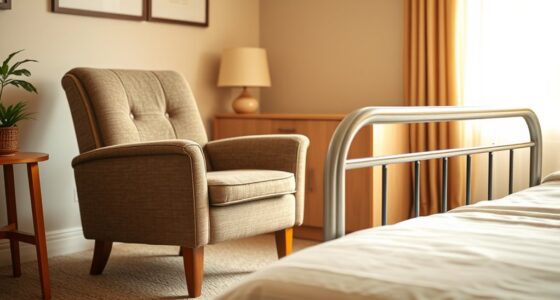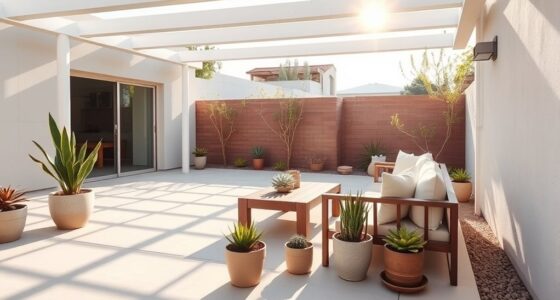Transform your home for effortless aging in place with these game-changing design tips. Start by prioritizing safety with non-slip flooring and wider doorways for easy access. Consider adjustable furniture for comfort, and optimize your kitchen for user-friendly access. Enhance your bathroom with grab bars and walk-in showers for added safety. Don't forget to make outdoor spaces inviting and invest in smart home technology for convenience. Discover even more ways to create a supportive and engaging environment.
Key Takeaways
- Incorporate non-slip flooring in key areas like kitchens and bathrooms to reduce fall risks and enhance safety for older adults.
- Create wider doorways and remove thresholds to ensure easy access for mobility aids like wheelchairs and walkers.
- Install grab bars and walk-in showers in bathrooms to provide essential support and eliminate tripping hazards during bathing.
- Use adjustable furniture, such as height-adjustable tables and chairs, to accommodate diverse needs and improve comfort during daily activities.
- Integrate smart home technology for easier task management, enhanced security, and improved visibility, promoting a safer living environment.
Prioritize Safety With Non-Slip Flooring

When it comes to creating a safe environment for older adults, prioritizing non-slip flooring is essential. Non-slip flooring greatly reduces the risk of falls, a leading cause of injury among older adults. Regular maintenance of essential safety equipment such as ensuring that non-slip mats are in good condition can further enhance safety in the home. Textured vinyl and rubber options provide excellent traction, making your kitchens and bathrooms safer where slip hazards are common. Installing non-slip mats with no-curl edges can enhance safety even further, preventing trips while keeping comfort in mind. Additionally, ensuring that the air quality is optimal with a reliable air purifier can further enhance the overall safety and comfort of the living environment. Improved air quality can significantly reduce allergen exposure, contributing to better respiratory health for older adults.
Ensure Accessibility With Wider Doorways

Creating an age-friendly home means guaranteeing that doorways are wide enough to accommodate mobility aids like wheelchairs and walkers. Aim for wider doorways, ideally at least 32 inches, to enhance accessibility for aging residents.
Consider installing lever-style door handles, which require less grip strength and are easier to operate. Removing thresholds creates a seamless shift between rooms, reducing tripping hazards and making navigation smoother. Additionally, mindful consumption of home improvement materials can lead to more sustainable and accessible design choices.
Keep doorways free of obstructions to promote a clutter-free passage, allowing for safe and comfortable movement throughout your home. Additionally, home improvement initiatives can significantly enhance the safety and functionality of these spaces.
Regularly assess and maintain these areas to guarantee they remain accessible as needs change, greatly contributing to the safety and independence of everyone in your space.
Create Comfortable Living Spaces With Adjustable Furniture
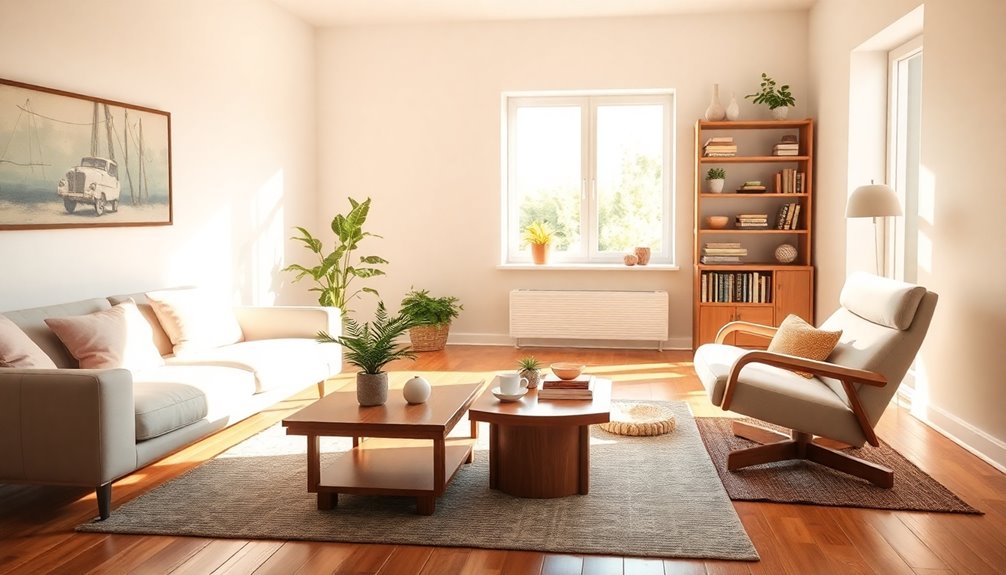
To foster comfort and accessibility in your living spaces, consider incorporating adjustable furniture that meets the diverse needs of older adults. This furniture allows you to customize space for ideal comfort and mobility. For instance, height-adjustable tables and chairs help you engage in daily activities without strain. Softer flooring paired with adjustable seating can reduce joint pressure, enhancing your comfort. Additionally, investing in best home security systems can ensure a safe and secure environment as you age in place. Regular veterinary check-ups can also be beneficial for any pets you may have, ensuring they remain healthy companions as you age. Furthermore, using lightweight designs in furniture can make it easier to rearrange your space as needed, promoting a more personalized living environment.
| Type of Furniture | Benefits | Features |
|---|---|---|
| Adjustable Beds | Enhanced support for sleeping | Head and foot elevation |
| Pull-Out Shelves | Minimized bending/reaching | Easy access to essential items |
| Modular Seating | Flexible configurations | Customizable for personal needs |
Optimize Kitchen Design for Ease of Use
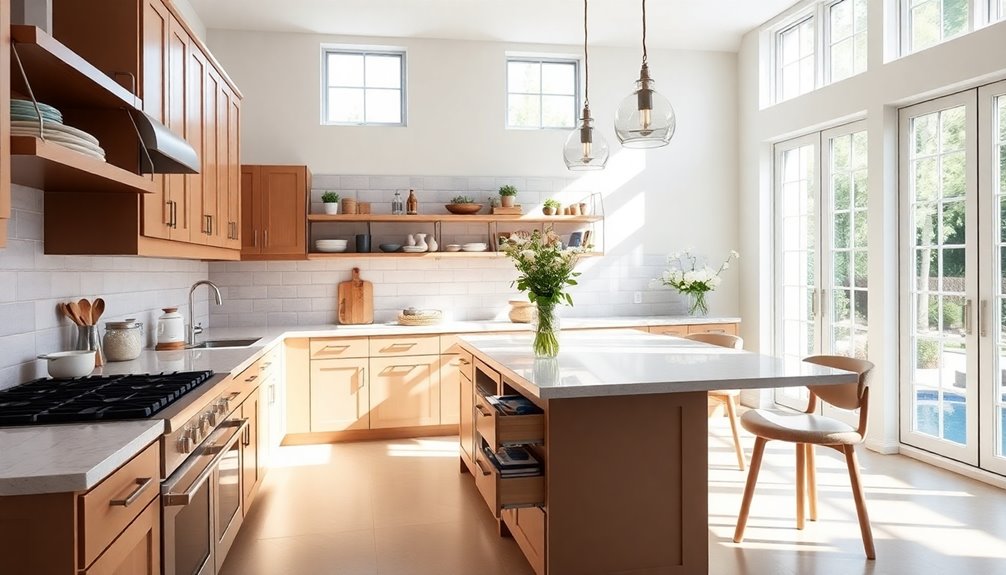
Optimizing your kitchen design for ease of use can considerably enhance daily activities for older adults.
Start by investing in adjustable countertops to accommodate various heights, making certain everyone can access all areas comfortably. Natural materials can also add warmth and aesthetic appeal to the space. A clean kitchen environment can also reduce allergens and improve overall indoor air quality.
Install pull-out shelves and drawers to minimize bending, making it easier to retrieve kitchen items without straining.
Use single-handle lever faucets in the sink for simple operation, allowing control over water flow and temperature with minimal effort.
Guarantee adequate lighting over key areas like the stove and sink to boost visibility and safety.
Finally, choose non-slip, anti-fatigue mats with no-curl edges to provide comfort while standing and prevent tripping hazards in high-traffic areas, creating a safer environment for aging in place. Regular air purifier maintenance can further improve indoor air quality, ensuring a healthier cooking environment.
Enhance Bathroom Safety With Grab Bars and Walk-In Showers
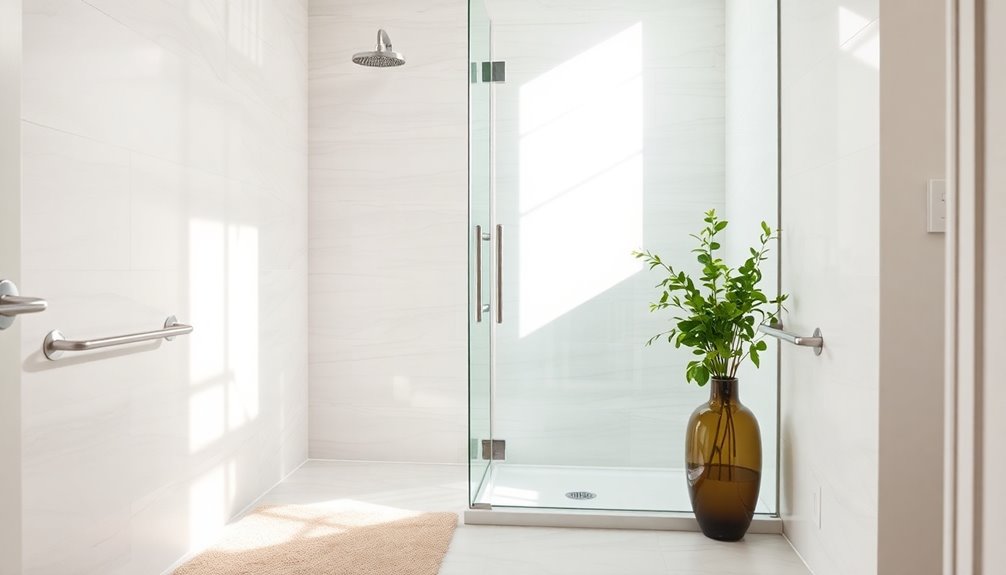
As you consider ways to enhance bathroom safety, installing grab bars and walk-in showers can make a notable difference for older adults.
Grab bars provide essential support and stability, reducing fall risks during daily routines. Strategically placing them at different heights guarantees you can use them comfortably, whether sitting or standing. Additionally, utilizing age-friendly design tips can help further improve overall safety and accessibility in your home. Installing these features may also be a cost-effective solution, as home security systems can provide both safety and peace of mind.
Walk-in showers eliminate tripping hazards with non-slip flooring, making bathing safer for individuals with limited mobility. Incorporating a shower seat allows you to sit while bathing, promoting independence and further reducing the risk of accidents. Additionally, regularly updating plans to incorporate safety features can ensure that the home remains adaptable to changing needs over time. By integrating essential elements like grab bars and proper shower design, you contribute to a safer living environment.
Design a Bedroom for Easy Access and Comfort
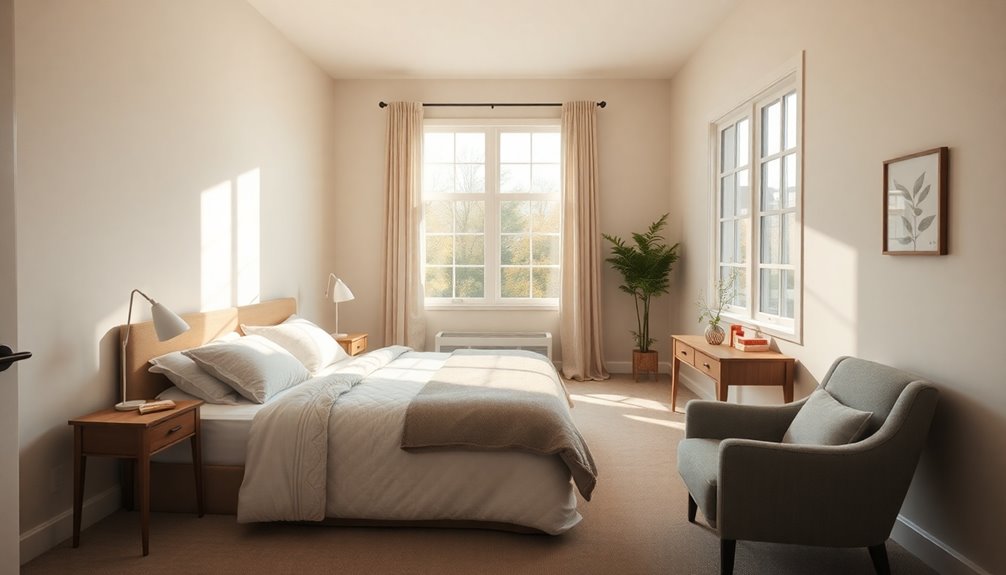
Creating a bedroom that prioritizes easy access and comfort can greatly enhance daily living for older adults.
Start by ensuring the bed height is between 20 to 23 inches for easy entry and exit, accommodating mobility aids. Incorporate electric adjustable beds to promote independence and facilitate easier shifts from sitting to standing. Additionally, consider using a HEPA filter air purifier to improve indoor air quality, which can significantly benefit respiratory health.
Install motion-sensor nightlights to illuminate pathways, reducing fall risks during nighttime trips. Utilize closet organizers with low-hanging rods and easy-to-reach drawers to minimize bending and stretching.
Choose soft, low-pile carpeting to provide warmth and comfort while reducing tripping hazards. Additionally, consider integrating holistic living elements in the bedroom to further promote well-being and a sense of peace.
Improve Hallways and Stairs With Handrails and Lighting

Maneuvering hallways and stairs can be challenging for older adults, making it vital to enhance safety through thoughtful design.
Installing handrails on both sides of staircases provides essential support, considerably reducing the risk of falls. Verify handrails are securely anchored and designed with a comfortable grip to accommodate varying strength levels.
Adequate lighting is equally important; consider using motion-sensor lights that activate automatically at night. This increases visibility and safety in these areas.
Utilize contrasting colors for handrails against their backgrounds to improve identification. Additionally, well-lit stairways with even overhead illumination and LED strip lights along step edges clearly mark boundaries, preventing accidents.
Together, these home modifications create a safer environment for aging in place.
Make Outdoor Spaces Inviting and Accessible

How can you transform your outdoor spaces into inviting and accessible environments for older adults?
Start by ensuring pathways are wide and level, featuring non-slip surfaces that accommodate mobility devices like wheelchairs and walkers.
Incorporate comfortable seating areas with shade to promote relaxation and social interaction, which is essential for mental well-being.
Use motion-sensor lighting to enhance safety during nighttime, reducing the risk of accidents.
Clear your outdoor areas of tripping hazards, and add railings or handholds near stairs and slopes for easier access.
Consider raised garden beds to encourage enjoyable gardening experiences without excessive bending, fostering both physical activity and engagement with nature.
These changes will make your outdoor spaces welcoming and safe for everyone.
Incorporate Smart Home Technology for Convenience

As you explore ways to enhance convenience in your home, incorporating smart home technology can be a game changer for older adults.
Voice-activated assistants can help you manage daily tasks like setting reminders, controlling smart lighting solutions, and adjusting thermostats with ease.
Home automation systems enhance security, enabling remote monitoring through cameras and smart locks, providing peace of mind.
Smart lighting, including motion-sensor lights, improves visibility, reducing the risk of falls during nighttime hours.
Plus, integrating voice-controlled smart appliances makes meal preparation simpler, allowing you to maintain your independence in the kitchen.
With these technologies, you're not just enhancing convenience; you're promoting a safer, more comfortable living environment that supports your lifestyle as you age in place.
Foster Social Connections With Thoughtful Living Spaces
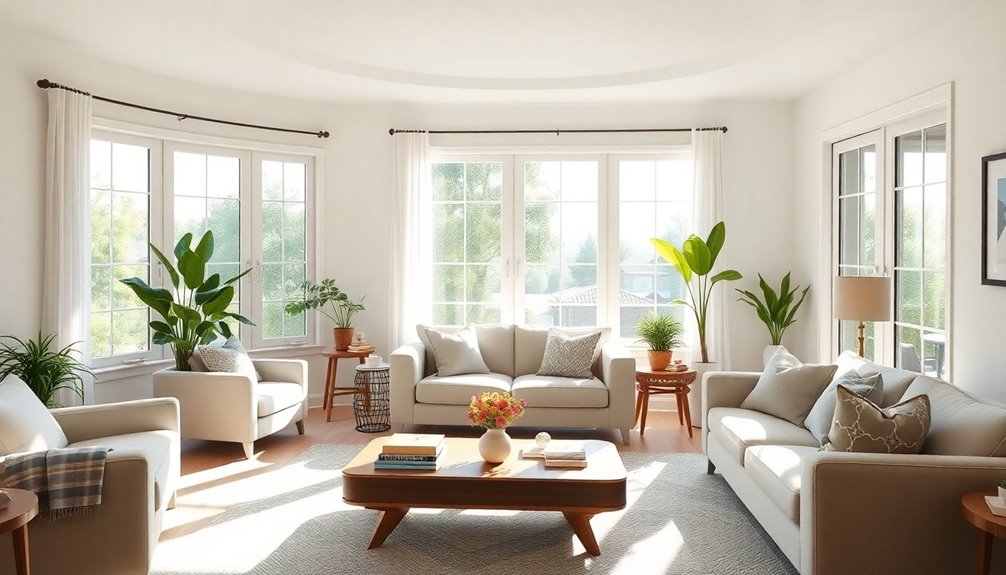
Creating a home that embraces smart technology not only enhances convenience but also sets the stage for fostering social connections.
Thoughtful design can transform your living space into a hub of interaction, enhancing mental well-being and reducing isolation.
Consider these ideas:
- Comfortable Living Rooms: Design inviting spaces for relaxation and conversation.
- Communal Dining Areas: Encourage shared meals that strengthen bonds and create memories.
- Hobby Spaces: Incorporate areas for crafts or games to boost engagement and cognitive health.
- Personalized Elements: Use family photos and mementos to evoke emotional connections and a sense of belonging.
With clear pathways and accessibility features, you'll make it easier for loved ones to visit, creating a vibrant, social atmosphere in your home.
Frequently Asked Questions
What Are the Best Materials for Non-Slip Flooring?
When it comes to non-slip flooring, you'll want to contemplate materials like vinyl, rubber, and textured tiles.
These options provide excellent traction and durability. Vinyl, especially with a matte finish, is both stylish and safe.
Rubber flooring is highly resilient and great for high-traffic areas, while textured tiles can enhance grip without sacrificing aesthetics.
Always make sure the surface is clean and maintained to keep it slip-resistant and safe for everyone.
How Can I Assess My Home for Accessibility Needs?
To assess your home for accessibility needs, start by walking through each room and identifying potential barriers.
Look for narrow doorways, steps, or uneven surfaces that might pose challenges. Consider your daily activities and how easily you can perform them.
Take note of lighting, furniture arrangement, and bathroom access. It's also helpful to involve someone else to gain a fresh perspective.
This way, you can create a comfortable and functional living space tailored to your needs.
What Types of Adjustable Furniture Are Available?
When you think about comfort, versatility, and style, adjustable furniture should come to mind.
You've got options like height-adjustable desks for your workspace, recliners that let you find your perfect position, and beds with adjustable bases to support your sleeping needs.
There are also modular sofas that can adapt to your space and preferences.
With these choices, you can create a home that feels just right for you, no matter your needs.
How Can Smart Home Technology Assist With Daily Routines?
Smart home technology can simplify your daily routines in numerous ways. You can use voice-activated assistants to control lights, adjust temperature, or set reminders for medications.
Smart appliances, like refrigerators that alert you when groceries are low, help you manage your kitchen efficiently. Additionally, automated security systems provide peace of mind, while smart locks allow for easy entry without fumbling for keys.
Embracing these technologies can make your life more convenient and enjoyable.
What Outdoor Features Enhance Safety for Older Adults?
Imagine a garden where every path is clear, sunlight dances on smooth surfaces, and gentle handrails whisper safety.
To enhance outdoor safety for older adults, you'll want to install well-lit pathways, non-slip surfaces, and sturdy handrails.
Consider adding benches for rest and incorporating raised garden beds for easy access.
These features create a nurturing environment, allowing them to enjoy the outdoors while feeling secure and supported in every step they take.
Conclusion
By embracing these essential age-friendly design tips, you can create a safe, stylish, and supportive sanctuary that enhances your everyday experience. Prioritizing practicality and promoting pleasant spaces will empower you to age gracefully in place. Remember, thoughtful touches transform your home into a haven of harmony, where comfort and convenience coalesce. So, take the leap toward a life of ease and elegance, ensuring every corner reflects your commitment to effortless aging and enduring enjoyment.



